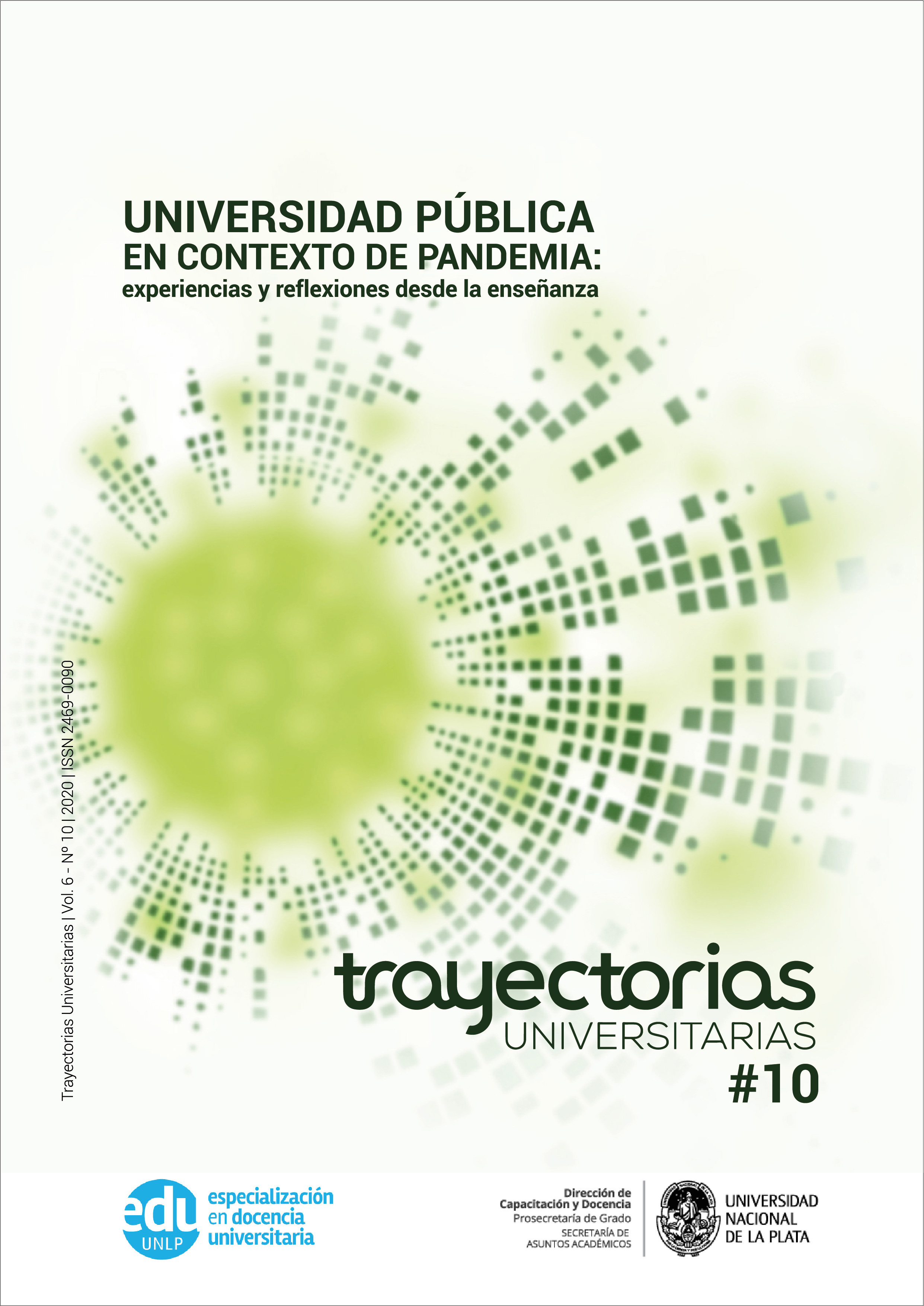Posibilidades y limitaciones del Trayecto de la Práctica en tiempos de Pandemia. El caso del Profesorado en Matemática de la UNR
DOI:
https://doi.org/10.24215/24690090e024Palavras-chave:
Profesorado en Matemática, Práctica Profesional Docente, Virtualización, PandemiaResumo
Este trabajo se ubica en el desarrollo del trayecto de la práctica docente en el contexto de pandemia del año 2020, tomando como caso el Profesorado en Matemática de la Universidad Nacional de Rosario. Esta Universidad, así como otras en el territorio nacional, ha optado por aproximarse a una pedagogía de la virtualización durante el período de aislamiento. Para la carrera en cuestión, el trayecto de la práctica docente se constituye en su proyecto articulador, en tanto se desarrolla intencional e integralmente del primer al cuarto y último año del plan de estudios. En este marco, el presente trabajo retoma testimonios de docentes de los espacios curriculares respectivos. Puntualmente las profesoras comparten pareceres y experiencias relativos tanto a las similitudes como a las diferencias con respecto al aula presencial en términos sociales, tecnológicos, institucionales y de contenido. También mencionan dificultades que están teniendo en este contexto y señalan, a su vez, aspectos que podrían estar potenciándose en comparación con lo que suele suceder en el aula presencial. Finalmente identifican limitaciones propias de la virtualidad para el desarrollo del trayecto de interés, sin dejar de apuntar posibilidades que en estas circunstancias están emergiendo. Estas reflexiones situadas permiten robustecer el conocimiento acerca de las adaptaciones de los dispositivos de formación para ser profesor/a en Matemática que se emplean en la carrera. Una comprensión del asunto desde la investigación educativa posibilita no solo responder a la coyuntura actual, sino seguir mejorando los mecanismos para contribuir a la sociedad con profesionales idóneos/as, con herramientas para descifrar las necesidades de su tiempo, en clave de compromiso social universitario.
PALABRAS CLAVE: Profesorado en Matemática, Práctica Profesional Docente, Virtualización, Pandemia.
Downloads
Métricas
Referências
Ball, D., Thames, M. & Phelps, G. (2008). “Content Knowledge for Teaching. What Makes It Special?”. Journal of Teacher Education, 59(5), 389-407.
Bartolomé, A. (2004). “Blended Learning. Conceptos básicos. Píxel-Bit”. Revista de Medios y Educación, (23), 7-20.
Consejo Interuniversitario Nacional (2013). Propuesta de Estándares para la Acreditación de los Profesorados Universitarios en Ciencias Exactas y Naturales (Res.CIN856/13). Buenos Aires, Argentina: Autor.
Copertari, S. y Trottini, A.M. (2013). “Experiencia a distancia Universitarias sin distancia. Hacia una pedagogía de la virtualización”. En S. Copertari y S. Morelli (Comp.) (2013). Experiencias Universitarias de Enseñanzas a Distancia: Praxis, visiones y horizontes (pp.53-81). Rosario, Argentina: Laborde.
Davini, M.C. (2015). “La formación en la práctica docente”. Buenos Aires, Argetina: Paidós.
Edelstein, G. (2015). “La enseñanza en la formación para la práctica”. Educación, Formación e Investigación, 1(1), 1-11.
Eisner, E. (1998). “El ojo ilustrado. Indagación cualitativa y mejora de la práctica educativa”. Buenos Aires, Argentina: Paidós.
Gerlero, C.A. (2014). “Los sentidos del compromiso social universitario. Una aproximación a la construcción del estado del arte”. Revista de la Escuela de Ciencias de la Educación, (9), 129-146.
González, F. (2000). “Los Nuevos Roles del Profesor de Matemática. Retos de la Formación de Docentes para el Siglo XXI”. Paradigma, 21(1), 139-172.
Kemelmajer, C. (09/04/2020). “Educación en tiempos de pandemia: consejos de especialistas para enriquecer las aulas virtuales”. CONICET. Recuperado de: https://www.conicet.gov.ar/educacion-en-tiempos-de-pandemia-consejos-de-especialistas-para-enriquecer-las-aulas-virtuales/
Mishra, P. y Koehler, M. (2006). “Technological pedagogical content knowledge: A framework for teacher knowledge”. Teachers College Record, 108(6), 1017-1054.
Maggio, M. (2012). “Enriquecer la enseñanza. Los ambientes con alta disposición tecnológica como oportunidad”. Buenos Aires, Argentina: Paidós.
Reimers, F.M. (08/05/2020). “El COVID-19 y la educación del futuro”. Proyecto Educar 2050. Recuperado de https://www.kaltura.com/index.php/extwidget/preview/partner_id/1633051/uiconf_id/42959361/entry_id/1_pn8nrtrb/embed/iframe?
Sanjurjo, L. (2005). “Volver a empezar. En L. Sanjurjo y X. Rodríguez”. Volver a pensar la clase. Las formas básicas de enseñar (pp.11-138). Rosario, Argentina: Homo Sapiens.
Sanjurjo, L. (2009). “Razones que fundamentan nuestra mirada acerca de la formación de las prácticas”. En L. Sanjurjo (Coord.). Los dispositivos para la formación en las prácticas profesionales (pp.15-40). Rosario, Argentina: Homo Sapiens.
Downloads
Publicado
Como Citar
Edição
Seção
Licença
La aceptación de un original por parte de la revista implica la cesión no exclusiva de los derechos patrimoniales de los/as autores/as en favor del editor, quien permite la reutilización, luego de su edición (postprint), bajo una Licencia Creative Commons Atribución-NoComercial-CompartirIgual 4.0 Internacional (CC BY-NC-SA 4.0).
Acorde a estos términos, el material se puede compartir (copiar y redistribuir en cualquier medio o formato) y adaptar (remezclar, transformar y crear a partir del material otra obra), siempre que a) se cite la autoría y la fuente original de su publicación (revista y URL de la obra), b) no se use para fines comerciales y c) se mantengan los mismos términos de la licencia.
La cesión de derechos no exclusivos implica que luego de su edición (postprint) en Trayectorias Universitarias los/as autores/as pueden publicar su trabajo en cualquier idioma, medio y formato; en tales casos, se solicita que se consigne que el material fue publicado originalmente en esta revista.
Tal cesión supone, también, la autorización de los/as autores/as para que el trabajo sea cosechado por SEDICI, el repositorio institucional de la Universidad Nacional de La Plata, y sea difundido en las bases de datos que el equipo editorial considere adecuadas para incrementar la visibilidad de la publicación y de sus autores/as.
Asimismo, la revista incentiva a los/as autores/as para que luego de su publicación en Trayectorias Universitarias depositen sus producciones en otros repositorios institucionales y temáticos, bajo el principio de que ofrecer a la sociedad la producción científica y académica sin restricciones contribuye a un mayor intercambio del conocimiento global.























